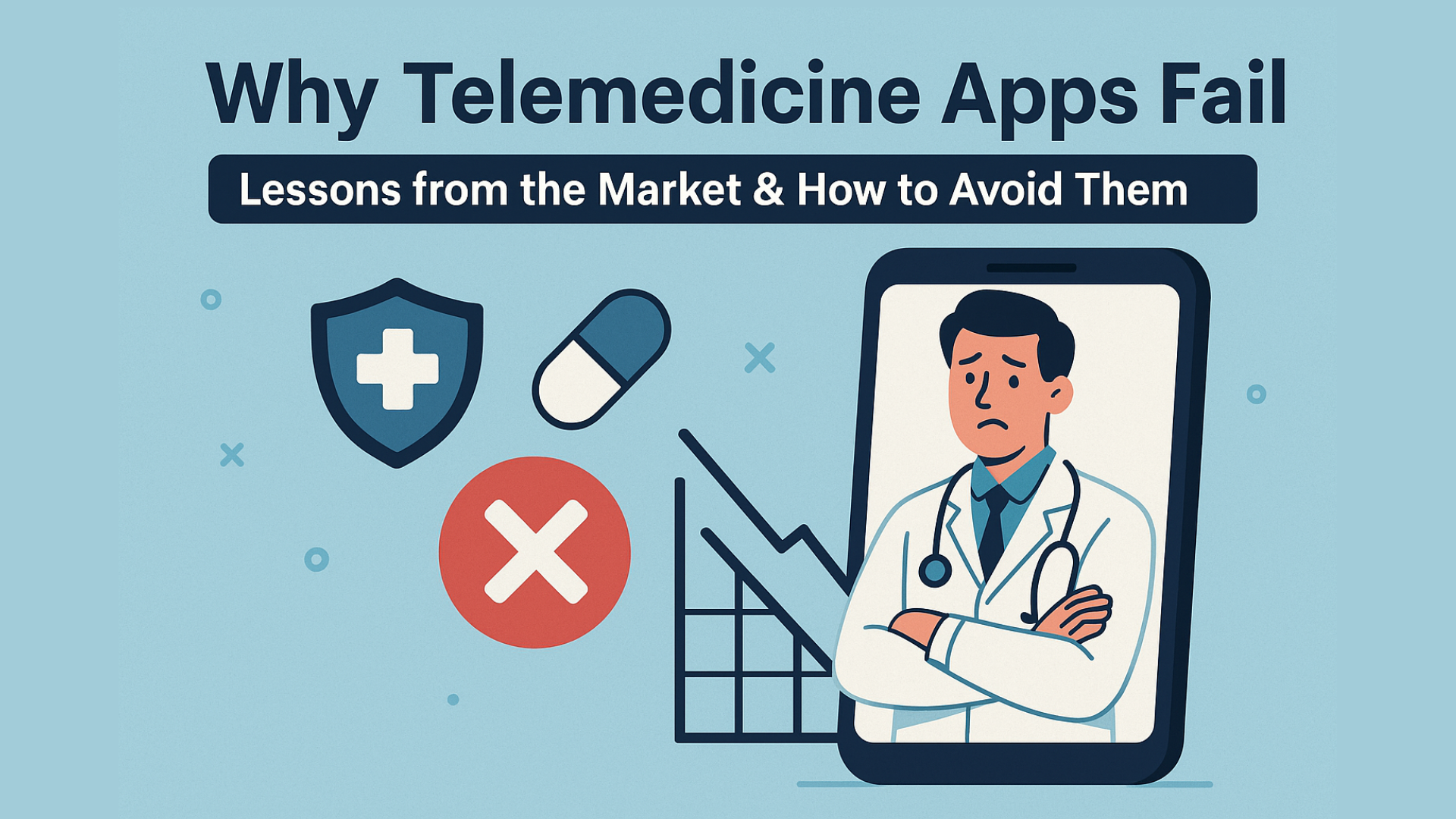Telemedicine was hailed as the future of healthcare during the pandemic. The idea of speaking to a doctor from your living room, skipping waiting rooms and hospital queues, caught on quickly. And for a while, it seemed unstoppable. Investment poured in. Apps mushroomed overnight. Patient onboarding went through the roof.
But then, something shifted.
Many of these once-promising apps started to struggle. Some shut down. Others were quietly acquired. A few pivoted away from direct-to-consumer models entirely. The reality? Building and sustaining a successful telemedicine app is harder than it looks.
So what went wrong—and more importantly, what can today’s healthtech founders and product teams do differently?
Real-World Examples of Telemedicine Apps That Struggled
MDLIVE (Acquired by Evernorth, Cigna’s Health Services Arm)
Once a leader in the space, MDLIVE offered virtual doctor visits and behavioral health services. But as competition intensified, MDLIVE couldn’t keep up. Technical glitches, limited interoperability with electronic health records (EHRs), and a transactional user experience held it back. Ultimately, it was acquired by Evernorth, which signaled both an end and a new beginning.
Lesson: Scaling fast without investing in backend infrastructure and meaningful patient engagement is a recipe for stagnation. Patients don’t just want fast consultations—they want continuity and quality.
HealthTap
HealthTap set out to revolutionize care with an AI-first model. But while automation can increase efficiency, HealthTap leaned too heavily on technology—sometimes at the cost of human connection. The overuse of chatbots and automated responses led to skepticism from users who expected empathy and expertise.
Lesson: Automation can enhance care, but it cannot replace the reassurance of a trained human professional. Trust is foundational in healthcare.
Veta Health
Veta Health focused on remote patient monitoring, particularly for chronic disease management. But despite tackling an important use case, the company struggled to differentiate itself. The product lacked a clear value proposition for end-users and healthcare providers alike. Eventually, it pivoted toward B2B partnerships rather than direct consumer engagement.
Lesson: In a crowded marketplace, a vague value proposition is indistinguishable. Clarity and niche focus are critical.
Why Telemedicine Apps Fail: The Deeper Issues
Failure isn’t usually the result of one bad decision. It’s a combination of strategic missteps, market misreads, and gaps in execution. Here are the most common reasons telemedicine apps fall short:
Poor User Experience and Design
Many apps are built with a “tech-first” rather than a “patient-first” mindset. Complicated sign-up processes, clunky navigation, or poor video/audio quality can frustrate users. Add to that a lack of accessibility features—for elderly patients or people with disabilities—and you’ve alienated your core audience.
How to avoid this: Design your app around the least tech-savvy user. Simplify every step. Invest in UX testing with real patients. Ensure accessibility compliance, and focus on reliability—because a failed video call isn’t just a tech issue, it’s a missed opportunity for care.
Neglecting Regulatory and Data Privacy Requirements
Telehealth operates in one of the most regulated industries. HIPAA in the US, GDPR in Europe, and similar laws elsewhere mandate strict data protection. Yet, many startups enter the space underestimating the legal weight of compliance.
How to avoid this: Build compliance into your product roadmap. Hire or consult with legal and healthcare compliance experts early. Ensure all third-party services you use (e.g., cloud storage, chat) are compliant. Patient data isn’t just sensitive—it’s sacred.
Lack of Integration with Existing Healthcare Systems
Doctors don’t want to juggle multiple dashboards. If your app doesn’t integrate with their existing EHR or EMR systems, it becomes a burden rather than a solution. Many telemedicine apps fail because they ignore the workflows of actual providers.
How to avoid this: Prioritize interoperability. Use established APIs and build partnerships with leading EHR vendors. The more your platform “plugs into” existing systems, the more likely it is to be adopted and retained.
Over-Reliance on Pandemic-Era Demand
During COVID-19, demand for virtual care spiked. Many telehealth apps rode that wave—but didn’t prepare for what came after. As clinics reopened, usage dropped. Apps that didn’t adapt to hybrid care models or offer long-term value began losing users.
How to avoid this: Don’t build for a crisis. Build for continuity. Offer features that support chronic care management, post-operative check-ins, and preventive screenings—use cases that persist beyond pandemics.
Trust Deficit
Patients are hesitant to share personal health information or take medical advice from a platform they don’t trust. If your app has inconsistent care quality, unclear provider credentials, or poor customer support, trust erodes fast.
How to avoid this: Make physician profiles visible and verifiable. Offer consistent quality of care and transparent pricing. Include patient feedback mechanisms and address concerns publicly and proactively.
One-Size-Fits-All Mentality
Telemedicine needs differ across demographics, conditions, and geographies. An app designed for millennials in urban India might not work for senior citizens in rural America. Apps that don’t tailor experiences struggle with engagement and retention.
How to avoid this: Customize your offering. Whether it’s pediatric care, dermatology, or mental health—specialization often outperforms generalization. Understand the unique needs of your target user segment and speak directly to them.
How to Build a Telemedicine App That Lasts
Avoiding failure isn’t just about dodging mistakes—it’s about intentionally building with the future in mind. Here’s how to set your app apart:
Focus on a Niche, Then Expand
Start by solving one specific problem exceptionally well. Apps like Nurx (birth control and sexual health) and Mindstrong (mental health) gained traction by owning a niche. Once you’ve established trust and traction, you can expand into adjacent areas.
Partner with Providers, Not Just Patients
Clinics, hospitals, and independent physicians are key stakeholders. Instead of trying to replace them, empower them. Offer tools that make their work easier—like scheduling, documentation, and patient follow-up features.
Make Data Work for the Patient
Apps that just digitize the appointment process miss the real opportunity: proactive, personalized care. Use patient data (with consent) to send health reminders, flag risks, and improve outcomes. The more value you create between appointments, the more likely patients are to stay.
Build Human Touch into the Digital Flow
Healthcare is emotional. People are scared, vulnerable, and often overwhelmed. Don’t let tech strip away empathy. Offer live support. Use familiar language, not medical jargon. And make sure every automated process still feels human.
Think Beyond the Freemium Model
Healthcare isn’t a consumer app where “free” wins. Charging for care isn’t just expected—it adds perceived value. Consider business models that involve insurance reimbursements, employer partnerships, or bundled subscriptions with labs and diagnostics.
Final Thoughts
The future of telemedicine isn’t just digital—it’s deeply human. The apps that succeed won’t be the flashiest or the fastest. They’ll be the ones that make patients feel heard, supported, and safe. They’ll partner with providers, respect regulations, and evolve with patient needs.
There’s still immense potential in telehealth. But the window for building shallow, short-term apps has closed. What’s needed now is care that’s continuous, connected, and thoughtful.
Build with that in mind, and you won’t just avoid failure—you’ll create something truly valuable.
Frequently Asked Questions (FAQs)
Is telemedicine still a viable business?
Yes—absolutely. While the initial surge during the pandemic has leveled off, the long-term shift toward digital and hybrid healthcare is irreversible. Chronic care management, mental health services, post-op recovery, and rural outreach remain strong use cases. Success now depends on building sustainable, compliant, and patient-centric platforms.
How much does it cost to build a successful telemedicine app?
Costs vary widely depending on the app’s complexity, integrations, and compliance needs. A basic MVP (Minimum Viable Product) with video consults, scheduling, and chat can cost anywhere between $50,000 to $150,000. Apps requiring HIPAA/GDPR compliance, EMR integrations, or AI-based triaging can exceed $500,000.
What features are critical for user retention in telemedicine apps?
Some of the most retention-driving features include:
- Easy onboarding and profile setup
- Reliable video and voice consultation
- Access to verified doctor profiles
- Secure chat and follow-up systems
- Prescription tracking and delivery
- Health data dashboards and reminders
Retaining users requires more than functionality—it requires trust, continuity, and value between visits.
How can I ensure regulatory compliance in different markets?
Start by identifying your primary markets (e.g., US, UK, EU, India) and their healthcare regulations. In the U.S., HIPAA compliance is non-negotiable. In Europe, GDPR governs data privacy. Work with healthcare-specific legal consultants and consider using compliant third-party vendors for storage, messaging, and video APIs. Document every compliance effort—it’s both a safety measure and a trust-building move.
How do I differentiate my app in a crowded market?
You don’t need to serve everyone—start by serving someone really well. Focus on a niche (e.g., elderly care, diabetes management, postpartum recovery). Build features specifically for that audience, speak their language, and solve a real pain point they face. Differentiation comes from clarity, not complexity.




